AI and Automation: R...
AI and Automation: Revolutionizing Industries with Advanced Technologies
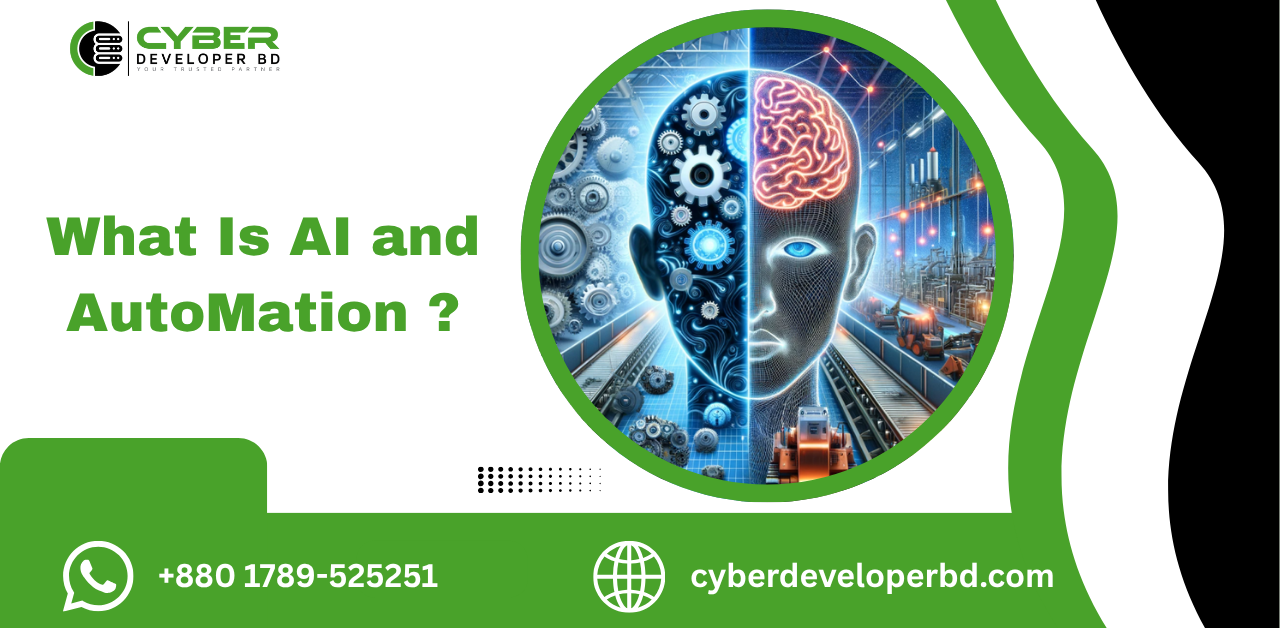
AI and Automation: Revolutionizing Industries with Advanced Technologies
In today’s fast-paced digital world, AI and automation are transforming how businesses operate, how we live, and how we interact with technology. From streamlining workflows to predicting future trends, these innovations are at the heart of modern progress. This comprehensive guide dives deep into the core concepts, exploring sub-topics like Artificial Intelligence, Machine Learning, Robotics, and more. Whether you’re a beginner or an expert, we’ll break it down step by step, explaining how these technologies work, their applications, and their impact on the future.
What is AI and Automation? A Step-by-Step Introduction
AI and automation refer to the integration of intelligent systems that mimic human cognition with processes that perform tasks without human intervention. Artificial Intelligence (AI) is the brain, while automation is the body that executes actions efficiently.
Step 1: Understanding Artificial Intelligence
Artificial Intelligence, often abbreviated as AI, is the simulation of human intelligence in machines. It enables computers to perform tasks that typically require human intellect, such as learning, reasoning, and problem-solving.
- Step-by-Step Breakdown:
- Data Input: AI systems start by gathering vast amounts of data from sources like sensors, databases, or user inputs.
- Processing: Algorithms analyze this data to identify patterns.
- Decision-Making: Based on patterns, the system makes predictions or decisions.
- Output and Learning: It provides results and refines itself through feedback loops.
For example, AI powers virtual assistants like Siri, which understand voice commands and respond accordingly. In AI and automation, AI acts as the decision engine, making automation smarter.
Step 2: The Role of Automation
Automation involves using technology to perform repetitive tasks. When combined with AI, it becomes “intelligent automation,” where systems adapt and improve over time.
- Benefits in Daily Life: Factories use automation for assembly lines, reducing errors and increasing speed.
- Integration with AI: AI enhances automation by predicting maintenance needs in machines, preventing breakdowns.
Together, AI and automation boost efficiency across sectors like manufacturing, healthcare, and finance.
Diving Deeper: Machine Learning in AI and Automation
Machine Learning (ML) is a subset of Artificial Intelligence where systems learn from data without explicit programming. It’s the fuel that powers many AI and automation applications.
Step-by-Step Explanation of Machine Learning
- Data Collection: Gather labeled or unlabeled data (e.g., images for object recognition).
- Model Training: Use algorithms to train the model on this data, adjusting parameters to minimize errors.
- Validation: Test the model on new data to ensure accuracy.
- Deployment: Integrate into automation systems, like chatbots that learn from user interactions.
- Iteration: Continuously retrain with new data for better performance.
ML algorithms include supervised learning (e.g., predicting house prices) and unsupervised learning (e.g., clustering customer segments). In AI and automation, ML automates data analysis, enabling predictive maintenance in factories.
Real-World Applications
- E-commerce: Recommends products based on browsing history.
- Healthcare: Analyzes medical images for early disease detection.
By 2025, ML is expected to automate 45% of repetitive tasks, according to industry reports.
Robotics: The Physical Side of AI and Automation
Robotics combines mechanical engineering with AI and automation to create machines that perform physical tasks.
Step-by-Step How Robotics Works
- Design and Sensors: Build robots with sensors (e.g., cameras, LIDAR) to perceive the environment.
- AI Integration: Use Artificial Intelligence for decision-making, like pathfinding algorithms.
- Automation Control: Program sequences for tasks, enhanced by Machine Learning for adaptability.
- Execution and Feedback: Robot performs actions, learns from outcomes (e.g., adjusting grip strength).
Examples include industrial robots in car manufacturing or surgical robots in hospitals. AI and automation in robotics reduces human error and increases precision.
Future Trends in Robotics
With advancements in Deep Learning, robots are becoming more autonomous, like self-driving delivery drones.
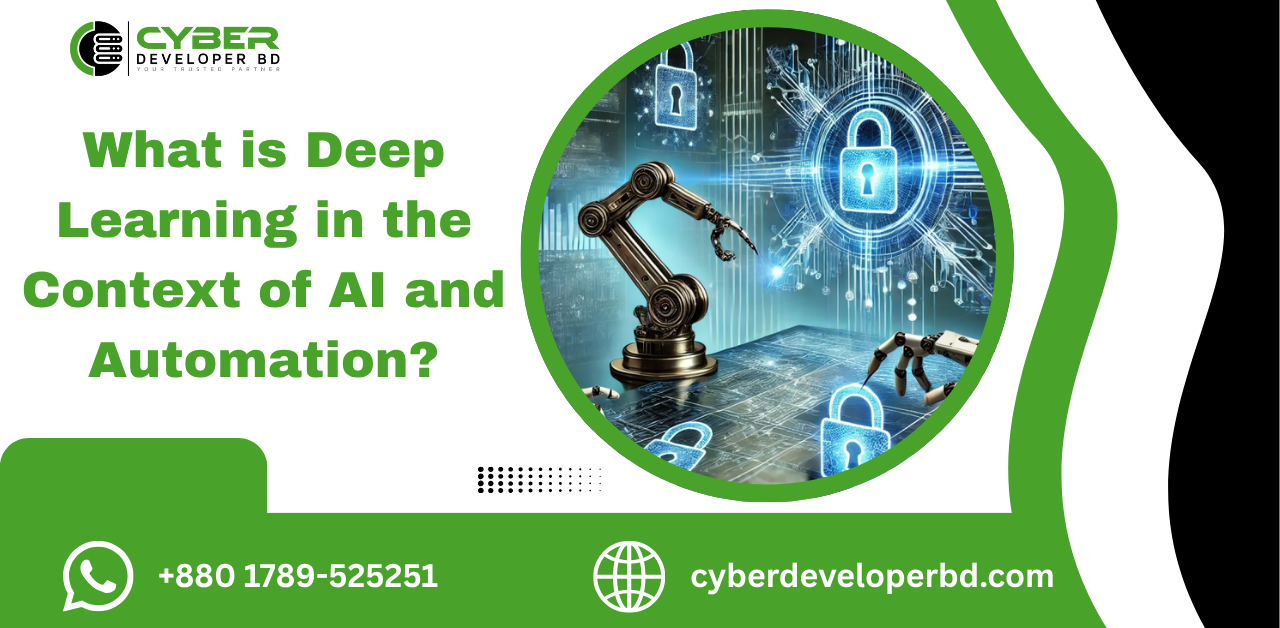
What is Deep Learning in the Context of AI and Automation?
Deep Learning: Advanced Neural Networks for Complex Tasks
Deep Learning is an advanced branch of Machine Learning that uses artificial neural networks with many interconnected layers to analyze and process complex patterns in large amounts of data. Unlike traditional algorithms that rely on manual feature extraction, deep learning models automatically learn to identify patterns, relationships, and representations within the data through repeated training.
Step-by-Step Deep Learning Process
- Input Layer:
The process begins by feeding raw data into the network — for example, the individual pixels of an image, audio waveforms, or text sequences. - Hidden Layers:
Multiple intermediate layers, known as hidden layers, perform a series of transformations to extract features from the data. These layers may detect simple patterns like edges or colors at first, and deeper layers capture more complex structures such as objects, faces, or linguistic meanings. - Output Layer:
The final layer produces a result, such as classifying an image as “cat” or “dog,” generating a translated sentence, or predicting numerical values. - Backpropagation:
The network uses a technique called backpropagation to compare its predictions with the actual results, calculate errors, and adjust the internal connection weights accordingly. This process is repeated many times until the model’s predictions become highly accurate. - Training with Big Data:
Deep learning requires large amounts of labeled data and powerful computational resources, often using GPUs or TPUs, to train models effectively over many iterations.
Applications in AI and Automation
In the fields of Artificial Intelligence and automation, deep learning drives major innovations such as Computer Vision in self-driving cars, Natural Language Processing (NLP) in voice assistants like Alexa and Siri, medical image analysis, facial recognition, and predictive analytics in various industries.
Challenges and Solutions
One major challenge in deep learning is overfitting, where a model performs extremely well on training data but poorly on unseen data. This happens when the model memorizes instead of generalizing patterns. Common solutions include regularization techniques, dropout layers, data augmentation, and cross-validation to ensure the model remains robust and performs accurately on new data. Additionally, balancing data, fine-tuning hyperparameters, and using early stopping can further enhance model performance.
Neural Networks: The Building Blocks of AI
Neural Networks are the fundamental technology behind modern Artificial Intelligence. They are computational models that mimic the structure and functioning of the human brain, consisting of a large number of interconnected nodes (neurons) organized in different layers. Each node processes information, passes it to other nodes, and together they learn to recognize complex patterns and relationships within data. Neural networks can learn from experience, adapt over time, and make intelligent predictions — much like how humans learn through observation and repetition.
Step-by-Step: Building a Neural Network
- Nodes and Layers:
A neural network is composed of several layers — an input layer, one or more hidden layers, and an output layer.- The input layer receives raw data such as numbers, text, or images.
- The hidden layers perform computations and extract patterns.
- The output layer generates final results like classifications or predictions.
The deeper the network (more hidden layers), the more complex the relationships it can learn.
- Weights and Biases:
Each connection between nodes has an associated weight, which determines how much influence one neuron has on another. A bias term is added to help the model make better adjustments. During training, these values are updated continuously to minimize errors and improve prediction accuracy. - Activation Functions:
Neural networks use activation functions (like ReLU, Sigmoid, or Tanh) to introduce non-linearity, allowing the model to capture complex, non-linear relationships in data. Without activation functions, the network would behave like a simple linear model and fail to understand intricate patterns. - Training:
During training, the network is fed with large amounts of labeled data. It computes an initial prediction, measures the loss (error) between predicted and actual results, and then uses an optimization algorithm such as gradient descent to adjust the weights and biases. This process is repeated across many iterations (epochs) until the model learns to make accurate predictions. - Deployment:
Once trained and validated, the neural network can be deployed into real-world systems. It can then process new data and make decisions automatically, enabling real-time automation — such as identifying defects in manufacturing, detecting fraud in finance, or predicting customer behavior in e-commerce.
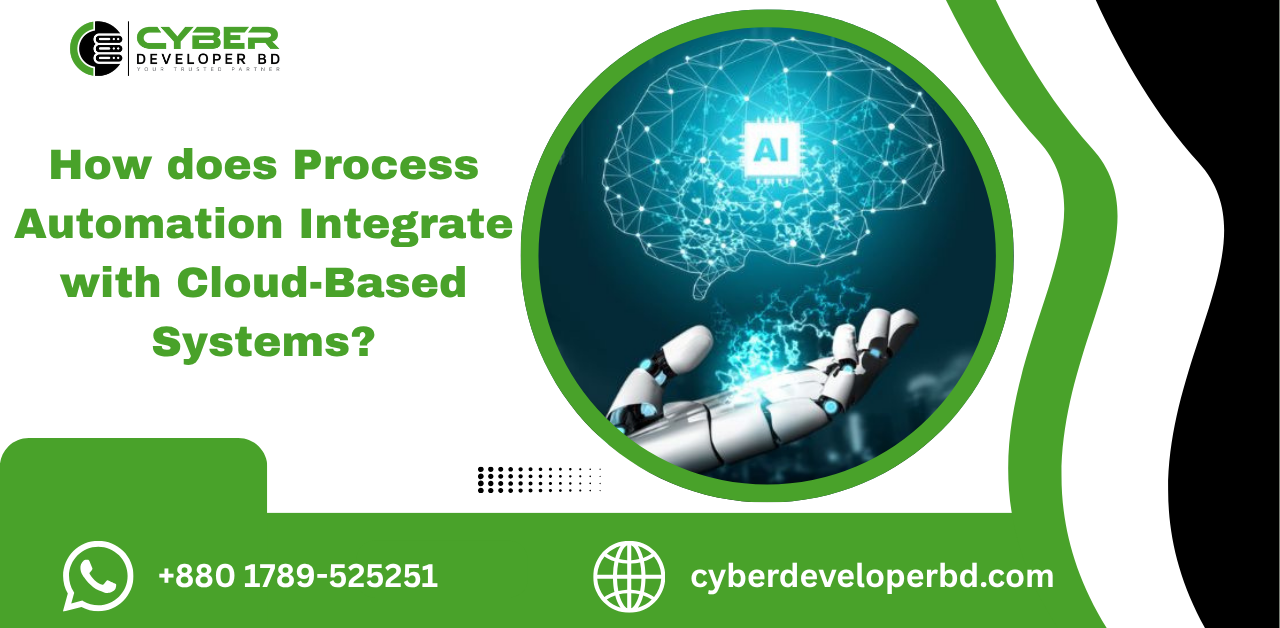
How does process automation integrate with cloud-based systems?
Process Automation: Streamlining Business Operations
Process Automation refers to the use of technology to automate repetitive, rule-based business processes, allowing organizations to operate more efficiently and with fewer human errors. Instead of employees spending time on routine manual tasks, automation software executes them automatically, freeing people to focus on strategic and creative work. Process automation not only improves accuracy and speed but also enhances productivity and consistency across different departments.
Step-by-Step Implementation
- Identify Tasks:
The first step is to analyze and identify repetitive tasks that are time-consuming or prone to error. Examples include invoice processing, data entry, customer onboarding, payroll management, or report generation. Mapping out these workflows helps determine which areas will benefit most from automation. - Tool Selection:
After identifying the right processes, organizations must select the most suitable automation tools. Common solutions include Robotic Process Automation (RPA) platforms like UiPath, Automation Anywhere, or Blue Prism, which can mimic human actions such as clicking, typing, and transferring data between systems. - Design Workflows:
Once the tools are chosen, teams design the automation workflows — defining each step of the process, setting rules, and specifying triggers that start automation. This step ensures the system performs tasks exactly as intended and handles exceptions properly. - Integration with AI:
To make automation smarter, Artificial Intelligence (AI) and Machine Learning (ML) can be integrated. For example, an AI model can analyze invoices, interpret text from emails, or make decisions based on data patterns. This transforms simple automation into intelligent automation, capable of handling complex decision-making tasks. - Monitoring and Optimization:
After deployment, continuous monitoring is essential to track performance, detect issues, and refine workflows for better efficiency. Analytics tools help measure the impact of automation — including time saved, errors reduced, and financial gains.
Robotic Process Automation (RPA): Software Robots at Work
Robotic Process Automation (RPA) is a technology that uses software robots, or “bots,” to perform routine digital tasks by mimicking human actions on a computer. These bots can interact with applications, websites, and systems just like a human user — clicking buttons, entering data, moving files, or sending emails — but they do it faster, more accurately, and without breaks. RPA is widely used to improve efficiency, reduce costs, and eliminate human error in repetitive business operations.
Step-by-Step RPA Setup
- Record Actions:
The process begins by recording user interactions on the computer — such as mouse clicks, keyboard inputs, or data entry steps — using RPA tools like UiPath, Blue Prism, or Automation Anywhere. These recordings help the system learn exactly how tasks are performed. - Configure Bots:
Once the actions are captured, rules and logic are defined for the bots. These rules determine when and how the bots will perform each step — for example, processing invoices, transferring data between systems, or updating customer records. The bots are then configured to run these repetitive, rule-based tasks automatically. - AI Enhancement:
To make RPA smarter, it can be integrated with Artificial Intelligence (AI) technologies such as Natural Language Processing (NLP), Optical Character Recognition (OCR), and Machine Learning (ML). This allows bots to handle unstructured data like emails, scanned documents, or chat messages — something traditional RPA alone cannot do. - Deployment:
After configuration, bots are deployed across systems and start executing tasks 24/7 without human supervision. They can work continuously, handle multiple operations at once, and ensure consistent accuracy and speed. - Scalability:
RPA systems are highly scalable — meaning organizations can easily expand automation from one process to hundreds across departments such as finance, HR, logistics, and customer service. As business needs grow, more bots can be deployed quickly without major infrastructure changes.
Data Analytics: Turning Data into Insights
Data Analytics is the process of examining, cleaning, transforming, and interpreting data to uncover meaningful patterns, trends, and insights that support better decision-making. It helps organizations understand what has happened, why it happened, and what is likely to happen next. In essence, data analytics turns raw information into actionable intelligence — enabling businesses to improve performance, predict future outcomes, and gain a competitive edge.
Step-by-Step Analytics Process
- Data Gathering:
The process begins with collecting data from multiple sources such as databases, websites, sensors, social media, and enterprise systems. This data can be structured (like spreadsheets) or unstructured (like text, images, or videos). The quality and diversity of collected data determine the accuracy of the insights. - Data Cleaning:
Once collected, the data is cleaned to remove duplicates, errors, or inconsistencies. Missing values are corrected, formats are standardized, and irrelevant data is filtered out. This step is crucial because high-quality, reliable data forms the foundation of accurate analytics. - Data Analysis:
Clean data is then analyzed using statistical techniques, data mining, or Machine Learning (ML) algorithms. These methods help identify correlations, detect trends, and uncover hidden patterns. For example, a retailer might analyze sales data to determine which products perform best during specific seasons. - Data Visualization:
Insights are then presented through visual representations such as charts, dashboards, or graphs. Visualization tools like Tableau, Power BI, or Google Data Studio make complex data easy to understand, helping decision-makers quickly identify key findings and take action. - Automation with AI:
In modern analytics systems, Artificial Intelligence (AI) and automation are used to generate real-time analytics. AI models can automatically detect anomalies, predict future trends, and deliver instant alerts or recommendations — without manual intervention.
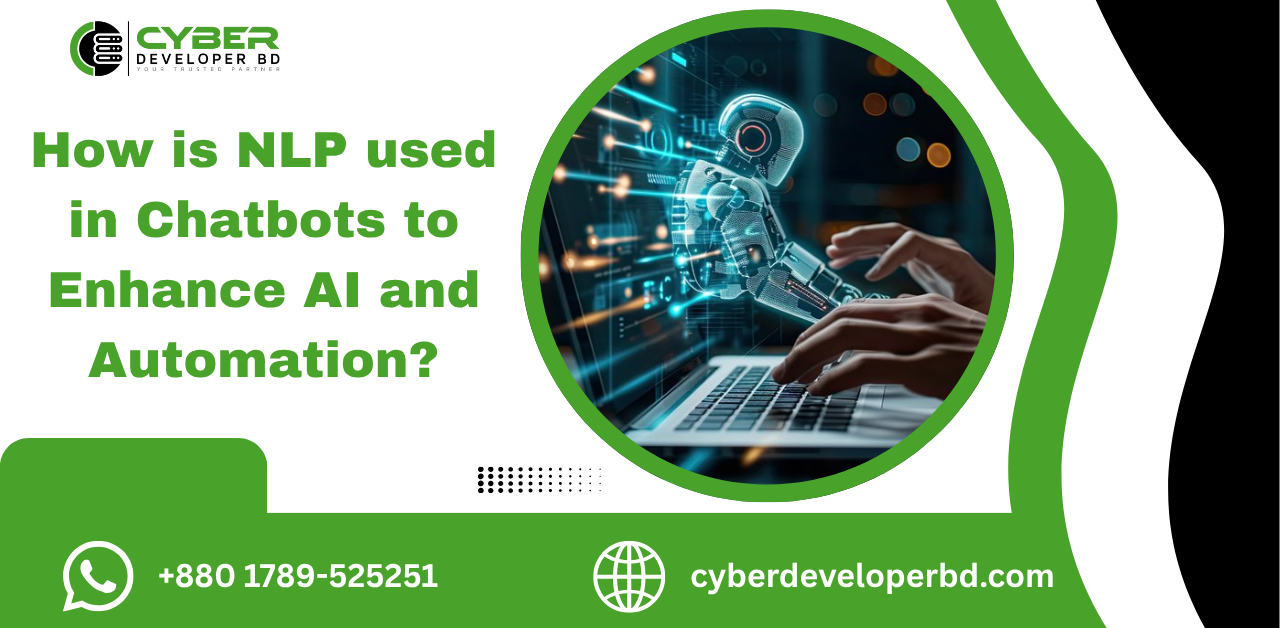
How is NLP used in Chatbots to Enhance AI and Automation?
Natural Language Processing (NLP): Making Machines Understand Humans
Natural Language Processing (NLP) is a field of Artificial Intelligence that enables computers to understand, interpret, and generate human language — both written and spoken. It bridges the communication gap between humans and machines, allowing systems to analyze text, recognize speech, and respond naturally. From virtual assistants like Siri, Alexa, and Google Assistant to chatbots and translation tools, NLP plays a key role in making technology more human-like and interactive.
Step-by-Step NLP Workflow
- Tokenization:
The process begins with breaking down sentences or paragraphs into smaller units called tokens — such as words or phrases. For example, the sentence “AI is changing the world” becomes [“AI”, “is”, “changing”, “the”, “world”]. This step helps computers understand the structure of language. - Part-of-Speech Tagging:
Each token is then analyzed to determine its grammatical role — whether it’s a noun, verb, adjective, or another part of speech. This step helps the system understand the meaning and relationship between words in a sentence. - Sentiment Analysis:
NLP algorithms can detect the emotion or tone behind text — whether it’s positive, negative, or neutral. For instance, analyzing customer reviews or social media comments can help companies understand customer satisfaction or brand perception. - Machine Translation:
NLP enables automatic language translation, allowing computers to convert text from one language to another — for example, translating an English paragraph into Bangla or vice versa. Tools like Google Translate and DeepL are popular examples of this application. - Integration with Automation:
Finally, NLP systems are integrated into chatbots, virtual assistants, and automated support systems. These AI-driven tools can understand customer queries, respond instantly, and even perform tasks like booking tickets, checking orders, or providing troubleshooting help.
Computer Vision: Teaching Machines to See
Computer Vision is a specialized branch of Artificial Intelligence that enables computers and machines to analyze, interpret, and understand visual data such as images and videos. It allows systems to recognize objects, detect movements, and make decisions based on visual input — much like how humans use their eyes and brain to perceive the world. This technology forms the backbone of modern innovations like self-driving cars, facial recognition, medical image analysis, and industrial automation.
Step-by-Step Process
- Image Acquisition:
The process begins with capturing visual data using cameras, sensors, or video feeds. These images act as raw input for the system. For example, security cameras in a smart city, or cameras in autonomous vehicles capturing road conditions. - Preprocessing:
The captured images are then enhanced and cleaned to improve their quality and remove distortions. Techniques such as noise reduction, contrast adjustment, and image normalization are applied to ensure the data is clear and consistent for further analysis. - Feature Extraction:
In this stage, important visual features — like edges, colors, textures, and shapes — are extracted using Deep Learning models, particularly Convolutional Neural Networks (CNNs). These features help the computer identify meaningful patterns in the visual data. - Object Detection:
Once the features are identified, the system performs object detection and classification to determine what objects are present and where they are located. For instance, a camera can detect vehicles, pedestrians, or traffic signs in real time. - Automation:
Finally, the analyzed visual data is integrated into automated systems for real-world applications. In factories, it’s used for quality control — detecting defective products; in healthcare, for identifying diseases from medical scans; and in robotics, for enabling vision-based navigation.
Intelligent Automation: The Next Level
Intelligent Automation (IA) represents the advanced stage of process automation, combining Robotic Process Automation (RPA), Artificial Intelligence (AI), and data analytics to create systems that can perform complex, cognitive, and decision-based tasks with minimal human intervention. Unlike traditional automation, which handles only repetitive rule-based tasks, Intelligent Automation allows machines to learn, adapt, and make decisions — enabling organizations to achieve faster, smarter, and more efficient operations.
Step-by-Step Evolution
- Basic Automation:
The first stage involves rule-based automation using RPA. Simple tasks like data entry, report generation, or invoice processing are automated to reduce manual work and human error. - Add AI for Cognitive Tasks:
Next, AI technologies such as Machine Learning, Natural Language Processing, and Computer Vision are integrated to handle unstructured data and complex decision-making. For example, AI-enabled bots can read and analyze emails, interpret documents, or respond to customer queries intelligently. - Scale Across Enterprises:
After initial deployment, Intelligent Automation is scaled across multiple departments and processes. This ensures consistency, accelerates operations, and allows businesses to manage large-scale workflows efficiently. - Benefits: Hyper-Automation:
Combining RPA, AI, and analytics leads to hyper-automation, where almost every repetitive and cognitive business process is automated. This results in cost reduction, improved productivity, faster decision-making, and enhanced customer experience.
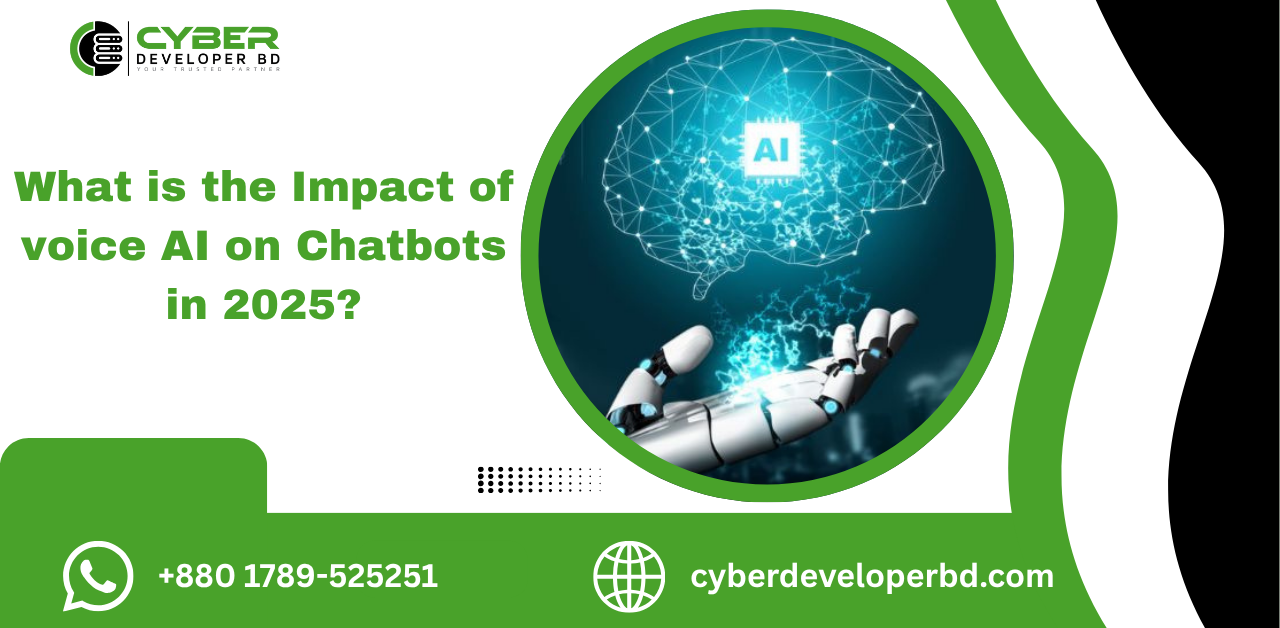
What is the impact of voice AI on chatbots in 2025?
Chatbots: Conversational AI in Action
Chatbots are AI-powered systems designed to interact with users using natural language, either through text or voice. By leveraging Natural Language Processing (NLP) and Machine Learning (ML), chatbots can understand user queries, provide relevant responses, and even perform tasks automatically. They are widely used in customer support, e-commerce, banking, healthcare, and virtual assistants to provide instant, personalized, and round-the-clock service.
Step-by-Step Building a Chatbot
- Define Intent:
The first step is to identify the user intents — what users are likely to ask or want. Examples include booking a ticket, checking an order status, asking for product information, or troubleshooting a problem. - Train the Model:
Using Machine Learning and NLP, the chatbot is trained on a dataset containing sample queries and responses. The model learns to understand the meaning behind user input, recognize keywords, and map questions to appropriate answers. - Integrate Automation:
Once trained, the chatbot is connected to business systems and automation workflows. For example, it can automatically process payments, update customer records, schedule appointments, or trigger alerts — reducing manual work and improving efficiency. - Test and Deploy:
The chatbot is thoroughly tested to ensure accuracy, reliability, and smooth user experience. After testing, it is deployed across platforms such as websites, mobile apps, social media, or messaging apps, ready to assist users 24/7.
Predictive Analytics: Forecasting the Future
Predictive Analytics is a branch of data analytics that uses historical data, statistical algorithms, and Machine Learning (ML) to forecast future events, trends, or behaviors. By analyzing patterns from past data, predictive analytics helps organizations make informed decisions, anticipate challenges, and identify opportunities. It is widely used across industries like finance, healthcare, retail, marketing, and supply chain management to improve strategy and operational efficiency.
Step-by-Step Method
- Historical Data Analysis:
The process begins with collecting and analyzing historical data. This includes sales records, financial transactions, patient health data, or customer interactions. Historical trends provide the foundation for building predictive models. - Model Building:
Using Machine Learning algorithms such as regression, decision trees, or neural networks, predictive models are created to capture patterns and relationships within the data. The model learns from past behavior to forecast future outcomes. - Validation:
The predictive model is tested and validated using a separate dataset to ensure its accuracy and reliability. Validation ensures that the predictions are not biased and perform well on new, unseen data. - Prediction:
Once validated, the model can predict future outcomes such as sales forecasts, risk of loan defaults, disease likelihood, or customer churn. These predictions help organizations make proactive and strategic decisions. - Automation Integration:
Predictive analytics can be integrated with automated systems to provide real-time insights. For example, financial institutions can automatically flag high-risk transactions, or healthcare systems can alert doctors about patients at risk of complications.
Autonomous Systems: Self-Operating Machines
Autonomous Systems are machines or devices capable of operating independently without human intervention, using a combination of sensors, Artificial Intelligence (AI), and control algorithms. These systems can perceive their environment, make decisions, and perform actions based on real-time data. Autonomous systems are at the forefront of modern AI and automation, enabling applications in transportation, robotics, manufacturing, and defense.
Step-by-Step Development
- Sensors and AI:
Autonomous systems rely on sensors (like cameras, LiDAR, GPS, or motion detectors) to gather data from the environment. Artificial Intelligence algorithms then process this data to understand surroundings, detect obstacles, and recognize patterns. - Decision Algorithms:
The system uses decision-making algorithms to determine the best course of action. For example, an autonomous car calculates safe speed, lane changes, and braking based on traffic conditions, while a delivery robot decides its optimal path to a destination. - Testing:
Rigorous testing and simulation ensure the system performs safely and reliably under different conditions. Testing includes both virtual simulations and real-world trials to handle scenarios like obstacles, system failures, or unexpected events. - Deployment:
After successful testing, the autonomous system is deployed in real-world environments. Examples include self-driving cars, drones for delivery, autonomous warehouse robots, and industrial machinery capable of performing tasks without human guidance.
Smart Technology: Connected and Intelligent Devices
Smart Technology refers to devices and systems that are connected, intelligent, and capable of interacting with each other and users. By combining Internet of Things (IoT) connectivity with Artificial Intelligence (AI), these devices can collect data, learn user preferences, and perform tasks automatically. Smart technology improves convenience, efficiency, and safety in everyday life, and is widely used in homes, offices, healthcare, transportation, and industries.
Step-by-Step Smart Home Setup
- Devices:
The first step is selecting smart devices such as lights, thermostats, security cameras, door locks, sensors, and appliances. These devices are equipped with IoT connectivity to communicate with each other and with a central hub. - Connectivity:
Devices are connected to a network, usually Wi-Fi, Bluetooth, or Zigbee, allowing them to exchange data. This network forms the backbone of a smart home, enabling seamless communication between devices and user interfaces like smartphones or smart speakers. - AI Control:
Artificial Intelligence algorithms analyze data from connected devices to make intelligent decisions. For example, smart thermostats learn user schedules to optimize temperature, or AI-enabled security cameras detect unusual activity and send alerts. - Automation Rules:
Users can define automation rules for devices to act automatically. For instance, lights can turn on when someone enters a room, the coffee machine can start brewing at a set time, or doors can lock automatically at night.
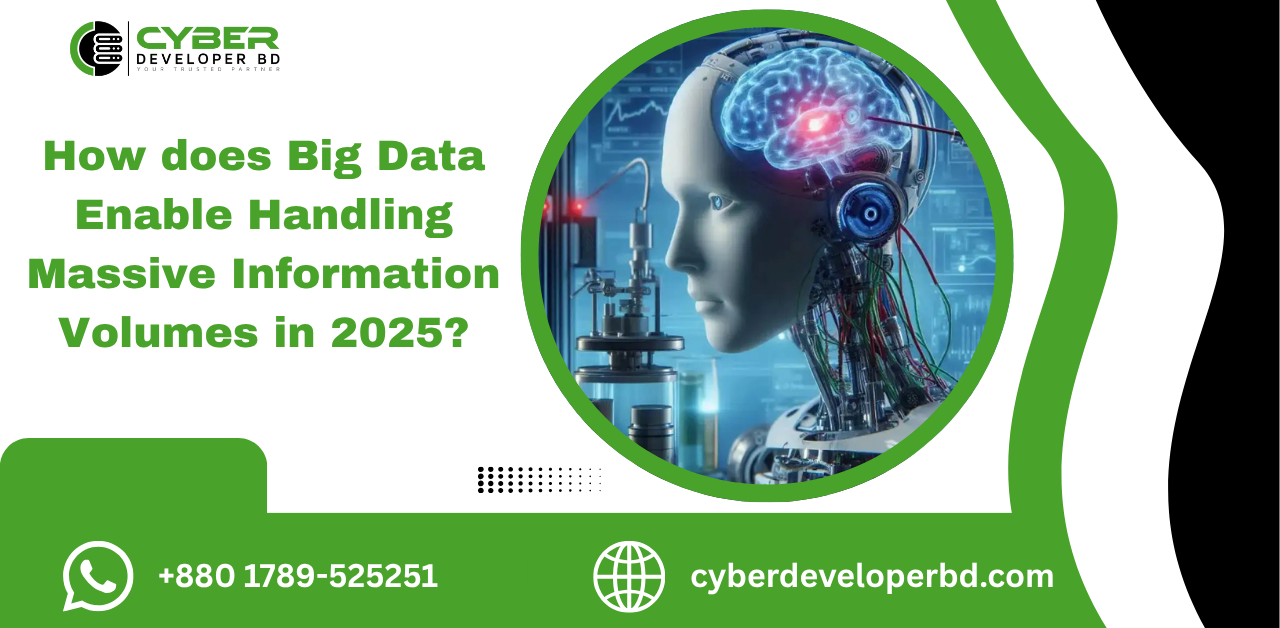
How does Big Data enable handling massive information volumes in 2025?
Big Data: Handling Massive Information
Big Data refers to the management and analysis of extremely large and complex datasets that traditional data processing tools cannot handle efficiently. These datasets come from sources such as social media, sensors, financial transactions, medical records, and IoT devices. Big Data enables organizations to uncover patterns, trends, and correlations, providing valuable insights for decision-making, AI, and automation across industries.
Step-by-Step Processing
- Storage:
Massive amounts of structured, semi-structured, and unstructured data are stored using scalable storage solutions such as distributed file systems, cloud storage, or data lakes. Technologies like Hadoop Distributed File System (HDFS) ensure data is safely stored and easily accessible. - Processing with Hadoop:
Big Data is processed using frameworks like Hadoop or Apache Spark, which can handle parallel computation across multiple nodes. This allows organizations to analyze enormous datasets efficiently and extract meaningful information from raw data. - Analytics with Machine Learning:
Once processed, Machine Learning (ML) and statistical analytics are applied to detect patterns, predict trends, and make intelligent decisions. For example, ML models can predict customer behavior, detect fraud, or forecast inventory needs. - Generating Insights:
The processed and analyzed data is transformed into actionable insights, often visualized through dashboards, charts, or reports. These insights enable businesses to optimize operations, improve customer experience, and make data-driven strategic decisions.
Internet of Things (IoT): Connecting Everything
The Internet of Things (IoT) refers to a network of connected devices and sensors that communicate and exchange data with each other over the internet. By linking everyday objects — from home appliances and wearable devices to industrial machinery and vehicles — IoT enables real-time monitoring, intelligent decision-making, and automation. It plays a vital role in creating smart homes, smart cities, and connected industries.
Step-by-Step IoT System
- Sensors:
IoT systems start with sensors and devices that collect data from the environment. Examples include temperature sensors, motion detectors, cameras, GPS trackers, and wearable health monitors. These sensors capture data continuously to monitor conditions or detect events. - Data Transmission:
Collected data is sent to central systems through communication networks such as Wi-Fi, Bluetooth, Zigbee, or cellular networks. Reliable transmission ensures that data reaches processing platforms for analysis in real time. - Cloud Processing:
The transmitted data is stored and processed in the cloud or distributed computing platforms. Cloud processing allows IoT systems to scale easily, handle large volumes of data, and make information accessible from anywhere. - AI Analysis:
Artificial Intelligence (AI) and Machine Learning (ML) analyze the data to detect patterns, predict outcomes, and make decisions. For example, AI can predict equipment failure in factories, optimize energy usage in buildings, or monitor traffic patterns in cities. - Automation Actions:
Finally, the IoT system triggers automated actions based on insights. Examples include adjusting thermostats, sending maintenance alerts, rerouting traffic, or controlling smart appliances — all without human intervention.
Cognitive Computing: Human-Like Thinking
Cognitive Computing is a branch of Artificial Intelligence that simulates human thought processes in a computerized model. It enables machines to understand, reason, learn, and interact naturally with humans. By combining AI, Machine Learning, Natural Language Processing, and data analytics, cognitive computing systems can analyze vast amounts of unstructured data, draw insights, and make decisions that resemble human reasoning. A well-known example of cognitive computing is IBM Watson, which can understand language, process complex queries, and provide recommendations.
Step-by-Step Process
- Data Input:
Cognitive computing systems begin by collecting and ingesting data from multiple sources, including structured databases, documents, emails, images, and videos. This wide variety of data helps the system understand context and complexity. - Learning:
Using Machine Learning algorithms, the system analyzes the data to identify patterns, relationships, and trends. Over time, it improves its understanding and becomes more accurate in predicting outcomes or providing insights. - Reasoning:
The system applies reasoning capabilities to interpret information, evaluate scenarios, and make informed decisions. It can weigh probabilities, consider alternatives, and simulate human-like problem-solving. - Output:
Finally, cognitive computing produces actionable outputs, such as recommendations, predictions, or natural-language responses. For instance, IBM Watson can assist doctors in diagnosing diseases or help businesses make data-driven decisions.
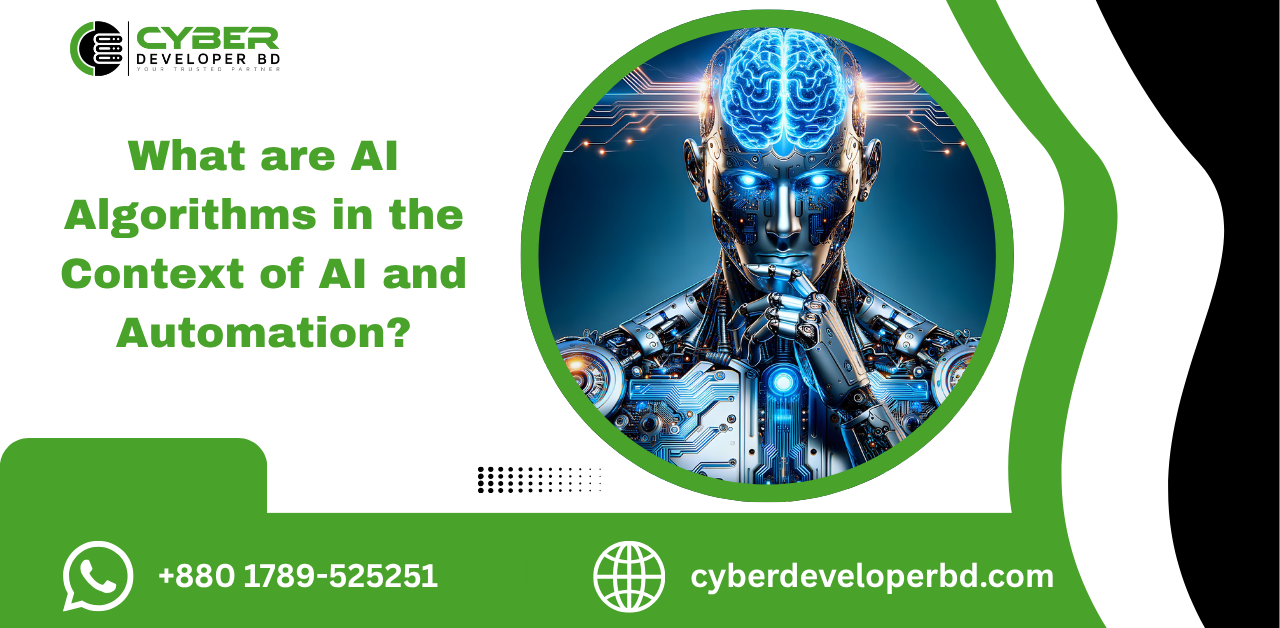
What are AI algorithms in the context of AI and automation?
AI Algorithms: The Core Logic
AI Algorithms are the core logic behind Artificial Intelligence systems. They are sets of rules and instructions that enable machines to analyze data, solve problems, and make decisions. AI algorithms are designed to handle various tasks — from pattern recognition and prediction to optimization and reasoning — forming the foundation of intelligent systems in automation, robotics, and data analytics.
Types of AI Algorithms
AI algorithms can be classified into several categories based on their purpose and approach:
- Search Algorithms: Help find solutions in complex spaces, such as pathfinding in robotics or puzzle-solving in games. Examples include A* algorithm and Breadth-First Search.
- Optimization Algorithms: Aim to find the best solution among many possible options. Commonly used in resource allocation, scheduling, and operational efficiency. Examples include Genetic Algorithms and Gradient Descent.
- Machine Learning Algorithms: Learn from data to make predictions or classifications. Examples include Linear Regression, Decision Trees, Support Vector Machines, and Neural Networks.
- Reinforcement Learning Algorithms: Learn through trial and error by receiving feedback from the environment. Examples include Q-Learning and Deep Q-Networks (DQN).
- Natural Language Processing Algorithms: Understand and generate human language. Examples include Text Classification, Sentiment Analysis, and Language Translation Models.
Step-by-Step Implementation of AI Algorithms
- Define the Problem:
Clearly identify the problem you want to solve, including objectives, inputs, outputs, and constraints. For example, predicting customer churn or optimizing delivery routes. - Choose the Algorithm:
Select the appropriate AI algorithm based on the problem type. For instance, use a classification algorithm for predicting categories, or an optimization algorithm for resource allocation. - Data Preparation:
Collect, clean, and preprocess data to make it suitable for the algorithm. This may include normalization, encoding, or feature selection. - Implement the Algorithm:
Apply the algorithm using programming tools or frameworks such as Python, TensorFlow, PyTorch, or scikit-learn. Train the model using historical or simulated data. - Evaluate and Optimize:
Test the algorithm’s performance using metrics like accuracy, precision, recall, or loss. Fine-tune parameters to improve results and ensure the solution meets objectives. - Deployment:
Integrate the algorithm into a real-world system or application to perform tasks automatically, such as recommending products, detecting fraud, or controlling autonomous vehicles.
Workflow Automation: Optimizing Processes
Workflow Automation refers to the process of streamlining and automating a series of business tasks or operations to improve efficiency, reduce errors, and save time. By mapping out repetitive processes and applying automation tools, organizations can ensure that tasks are completed consistently and quickly. Workflow automation is widely used in finance, HR, marketing, customer service, and IT operations to reduce bottlenecks and enhance productivity.
Step-by-Step Implementation
- Map Workflows:
Begin by analyzing and documenting existing workflows. Identify all tasks, their sequence, dependencies, and bottlenecks. For example, mapping the steps involved in processing invoices or onboarding new employees. - Automate Steps:
Once workflows are mapped, select appropriate automation tools like Robotic Process Automation (RPA) platforms or workflow software. Automate repetitive tasks such as data entry, approval routing, notifications, and report generation. - Integrate AI:
Enhance automation with Artificial Intelligence (AI) to handle cognitive tasks, like decision-making, analyzing unstructured data, or responding to customer queries. For example, AI can analyze customer requests and route them to the correct department automatically. - Monitor and Optimize:
Continuously monitor workflows to ensure tasks are running smoothly and identify areas for improvement. Analytics dashboards can track performance, detect delays, and provide insights for further optimization.
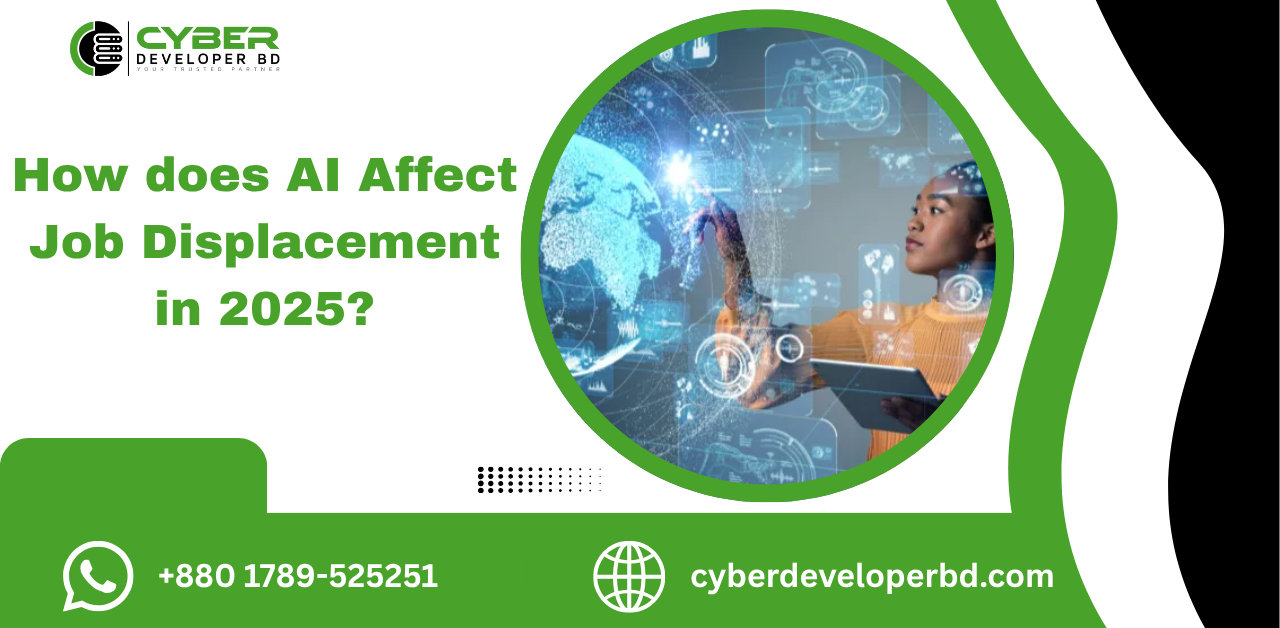
How does AI affect job displacement in 2025?
The Impact of AI and Automation on Society
Artificial Intelligence (AI) and Automation are transforming society by reshaping industries, creating new opportunities, and changing the way people work. While AI and automation create high-tech jobs in areas like data science, AI development, robotics, and cybersecurity, they also displace roles that involve repetitive or routine tasks, such as assembly-line work, basic data entry, and certain administrative positions.
Ethical considerations are critical in AI adoption. Algorithms can unintentionally introduce bias, leading to unfair decisions in hiring, lending, or law enforcement. Privacy concerns also arise as AI systems collect, analyze, and store massive amounts of personal data. Ensuring transparency, accountability, and fairness in AI systems is essential to maintain trust in society.
Step-by-Step Adoption of AI and Automation
- Train the Workforce:
Equip employees with skills in AI, automation tools, and data analytics. Upskilling and reskilling programs help workers adapt to new roles in a changing job market. - Implement Gradually:
Introduce AI and automation step by step, starting with pilot projects in specific departments. Gradual implementation allows organizations to evaluate impact, refine processes, and mitigate disruptions. - Monitor and Adjust:
Continuously assess social, ethical, and operational impacts, adjusting strategies to balance productivity gains with workforce well-being.
The Future of AI and Automation
By 2030, AI and automation could contribute up to $15.7 trillion to the global economy, driving growth across sectors such as manufacturing, healthcare, finance, and logistics. Emerging trends shaping the future include:
- AI Ethics: Greater focus on fairness, accountability, transparency, and reducing bias in AI systems.
- Quantum Computing Integration: Combining AI with quantum computing to solve complex problems faster, from climate modeling to drug discovery.
- Human-AI Collaboration: AI tools augmenting human intelligence rather than replacing it, creating more creative and strategic work.
Conclusion
AI and Automation, driven by cutting-edge technologies such as Machine Learning, Deep Learning, Robotics, Natural Language Processing, and IoT, are fundamentally reshaping industries, society, and the global economy. From streamlining business operations and enhancing customer experiences to enabling autonomous systems and smart technologies, their influence is both broad and deep.
Through step-by-step explorations of Neural Networks, RPA, Predictive Analytics, Computer Vision, Cognitive Computing, and Intelligent Automation, we’ve seen how these technologies analyze data, make decisions, and perform complex tasks — often faster and more accurately than humans.
Embracing AI and automation is no longer optional; it is essential for innovation, efficiency, and competitive advantage. By understanding their principles, applying them responsibly, and integrating them strategically, businesses and individuals can unlock new opportunities, drive growth, and shape a smarter, more automated future.
FAQ: Artificial Intelligence and Automation
- What is AI and automation?
Ans: AI and automation combine intelligent decision-making with automated task execution to increase efficiency, reduce errors, and streamline operations in business and technology. - How does Artificial Intelligence work?
Ans: AI processes large volumes of data using algorithms to mimic human intelligence, learning from patterns and improving over time. - What is Machine Learning?
Ans: A subset of AI where systems learn from experience and improve performance without explicit programming. - How is Robotics related to AI?
Ans: Robotics uses AI for perception, decision-making, and adaptive actions, allowing robots to operate autonomously in dynamic environments. - What is Deep Learning?
Ans: An advanced ML technique using multi-layered neural networks to process complex data such as images, audio, and text. - Explain Neural Networks.
Ans: Interconnected nodes that process information like the human brain, enabling AI models to learn, recognize patterns, and make predictions. - What is Process Automation?
Ans: Automating repetitive business processes to reduce manual effort, minimize errors, and improve efficiency. - How does Robotic Process Automation (RPA) differ from traditional automation?
Ans: RPA mimics human interactions with software, including handling unstructured data and integrating AI for intelligent decision-making. - What role does Data Analytics play in AI?
Ans: It extracts insights from raw data, which AI systems use to make predictions, recommendations, and smarter decisions. - What is Natural Language Processing (NLP)?
Ans: NLP enables machines to understand, interpret, and generate human language, allowing for tasks like chatbots, translation, and sentiment analysis. - How does Computer Vision function?
Ans: Computer Vision analyzes images and videos using AI, allowing machines to recognize objects, detect patterns, and interpret visual data. - What is Intelligent Automation?
Ans: The combination of AI, RPA, and analytics to create end-to-end automated processes capable of handling complex and cognitive tasks. - How do Chatbots use AI?
Ans: Chatbots employ NLP and ML to understand user queries and provide automated, context-aware responses, improving customer service. - What is Predictive Analytics?
Ans: Using historical data and machine learning, predictive analytics forecasts future events and trends, helping organizations make proactive decisions. - Explain Autonomous Systems.
Ans: Machines capable of self-operation without human input, such as drones, autonomous vehicles, and robotic manufacturing systems. - What is Smart Technology?
Ans: Devices enhanced with AI that can react intelligently to user behavior, often connected via IoT to automate tasks in homes or industries. - How does Big Data support AI?
Ans: Big Data provides the volume, variety, and velocity of data needed to train AI models for accuracy and predictive power. - What is the Internet of Things (IoT)?
Ans: A network of connected devices that communicate, collect data, and automate tasks, enabling smart homes, cities, and industries. - Define Cognitive Computing.
Ans: Systems that simulate human thought processes, reasoning, and decision-making to solve complex problems. - What are AI Algorithms?
Ans: Mathematical and logical instructions that enable AI to perform tasks such as classification, prediction, and optimization. - How does Workflow Automation improve businesses?
Ans: By streamlining sequences of tasks, workflow automation reduces time, errors, and bottlenecks, increasing operational efficiency. - Is AI replacing jobs?
Ans: AI automates routine and repetitive tasks, but it also creates new roles in technology, data analysis, and AI development. - What ethical issues arise in AI and automation?
Ans: Key concerns include algorithmic bias, privacy violations, and workforce displacement, requiring thoughtful policies and governance. - How is AI used in healthcare?
Ans: AI assists in diagnostics, personalized treatment, robotic surgeries, and predictive patient monitoring. - What is the future of Robotics?
Ans: Robotics is moving toward collaborative robots (cobots) that work safely alongside humans to enhance productivity. - How does Deep Learning differ from Machine Learning?
Ans: Deep Learning uses neural networks with multiple layers, allowing deeper understanding and processing of complex data compared to traditional ML. - Can Neural Networks learn on their own?
Ans: Yes, through training with large datasets and algorithms like backpropagation, neural networks can improve without manual programming. - What tools are used in Process Automation?
Ans: Popular tools include Zapier, Microsoft Power Automate, UiPath, and Automation Anywhere for automating workflows. - Is RPA suitable for small businesses?
Ans: Yes, RPA is scalable, cost-effective, and ideal for automating repetitive tasks in small to medium enterprises. - How does Data Analytics integrate with Big Data?
Ans: Analytics tools process Big Data to extract actionable insights, enabling data-driven decision-making at scale. - What applications use NLP?
Ans: Applications include translation services, sentiment analysis, voice assistants, chatbots, and document summarization. - How accurate is Computer Vision?
Ans: With advanced models, Computer Vision can reach up to 99% accuracy in tasks like facial recognition, object detection, and medical imaging. - What industries benefit from Intelligent Automation?
Ans: Finance, manufacturing, healthcare, logistics, and customer service industries gain efficiency, reduced errors, and cost savings. - Are Chatbots secure?
Ans: Yes, with proper encryption, secure APIs, and AI monitoring, chatbots can safely handle sensitive data. - How reliable is Predictive Analytics?
Ans: Reliability depends on data quality, diversity, and model training. High-quality datasets ensure accurate and actionable predictions. - What powers Autonomous Systems?
Ans: Autonomous systems rely on sensors, AI algorithms, real-time data processing, and decision-making frameworks. - How does Smart Technology save energy?
Ans: By automating devices such as lights, thermostats, and appliances based on usage patterns and occupancy, reducing waste. - What challenges does IoT face?
Ans: Key challenges include security vulnerabilities, data privacy concerns, device interoperability, and network reliability. - Is Cognitive Computing the same as AI?
Ans: No, Cognitive Computing is a branch of AI that specifically focuses on mimicking human reasoning and learning for problem-solving. - How can I start learning about AI Algorithms?
Ans: Begin with online courses on platforms like Coursera, edX, or Udemy, focusing on basics like linear regression, decision trees, and neural networks, then progress to advanced ML and deep learning topics.

